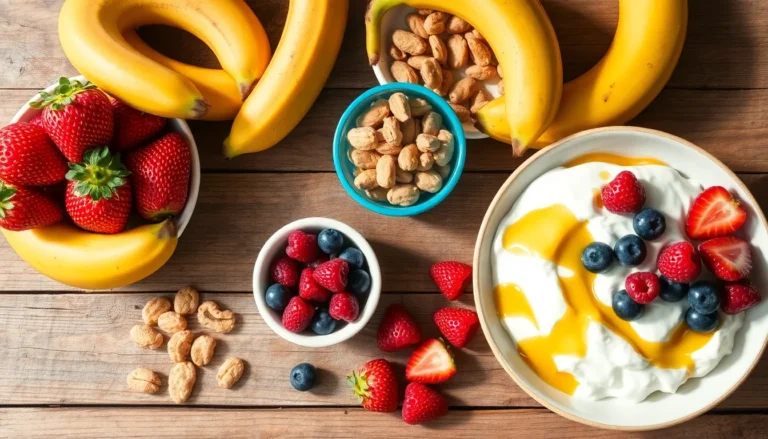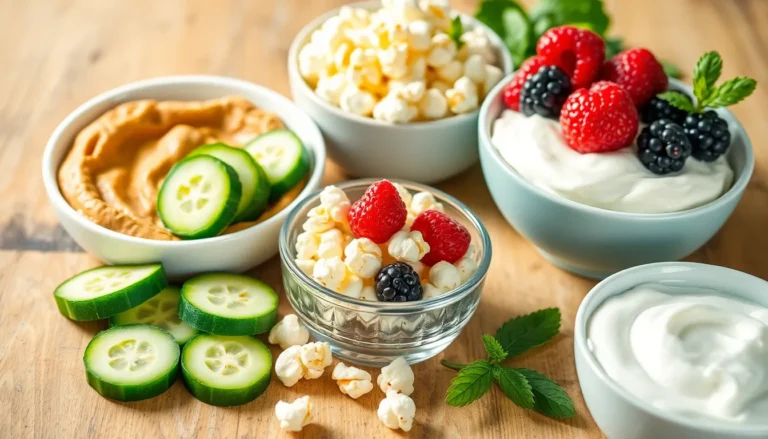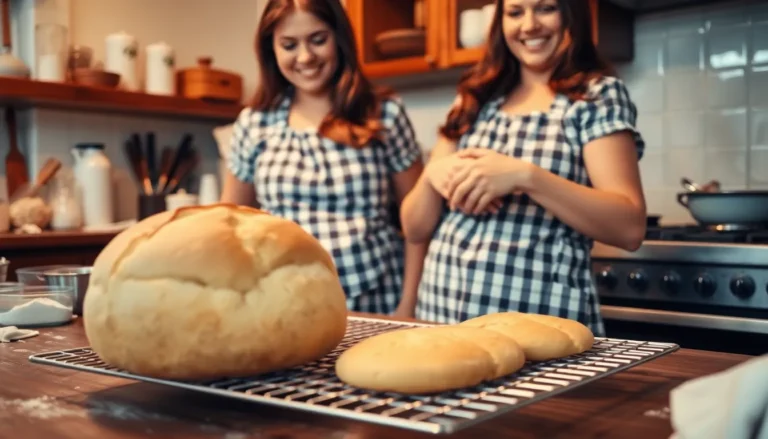Table of Contents
ToggleThere’s something magical about the aroma of homemade bread wafting through the kitchen. It’s like a warm hug that wraps around you, whispering sweet nothings of comfort and nostalgia. Forget those store-bought loaves that taste like cardboard; homemade bread is the real deal. It’s fluffy, it’s crusty, and it’s made with love—plus, you can finally impress your friends with your newfound culinary skills.
What Is Homemade Bread?
Homemade bread refers to any bread made from scratch using basic ingredients such as flour, water, yeast, and salt. The process of creating it involves mixing, kneading, and allowing the dough to rise, resulting in a product that is fresh and full of flavor.
Many bakers appreciate the opportunity to experiment with various recipes, incorporating different ingredients like seeds, herbs, or grains. Such variations allow for endless possibilities, creating unique textures and flavors.
The defining characteristic of homemade bread is the absence of preservatives. Unlike store-bought varieties, which often contain additives, homemade options prioritize freshness and quality.
Baking at home provides control over ingredients, allowing for healthier choices and accommodating dietary needs. People can easily adjust recipes to be gluten-free or add whole grains, aligning with personal preferences.
A distinct feature of homemade bread is its texture. Fluffy inside while maintaining a deliciously crusty exterior, it offers a satisfying mouthfeel. This contrasts sharply with the often uniform and bland texture of commercial bread.
Another significant factor is the aroma it brings to the kitchen. The smell of bread baking creates a warm, inviting atmosphere that evokes feelings of nostalgia. The sensory experience of pulling warm bread from the oven becomes a cherished moment for many.
Many find joy in the simplicity of the process. Mastering bread-making techniques fosters a sense of accomplishment. By sharing homemade bread, one can impress friends and enhance culinary skills, turning a simple loaf into a delightful experience.
Benefits Of Homemade Bread

Homemade bread delivers numerous advantages, enhancing both health and culinary enjoyment.
Healthier Ingredients
Quality shines through in homemade bread with the use of fresh, natural ingredients. Bakers choose flour, water, yeast, and salt without any preservatives. They customize recipes to include whole grains, seeds, or herbs, promoting nutritional value. Many individuals embrace gluten-free alternatives, accommodating specific dietary needs. Controlling ingredient selection fosters healthier eating habits, allowing bakers to avoid unwanted additives found in store-bought options. Each loaf reflects personal preference, ensuring a fresh and wholesome product.
Cost-Effective
Baking bread at home proves to be more economical compared to purchasing commercial varieties. Basic ingredients like flour and yeast are relatively inexpensive, yielding multiple loaves. Over time, the cost savings accumulate, especially for families or regular consumers. Enjoying gourmet flavors without premium prices becomes achievable through homemade bread. The potential for zero waste also arises since home bakers can utilize leftover ingredients from other meals. Investing in homemade bread signifies a smart choice for budget-conscious individuals and families.
Essential Tools For Making Homemade Bread
Creating homemade bread requires specific tools for optimal results. Bakers can achieve the best texture and flavor by utilizing the right equipment and ingredients.
Baking Equipment
Baking equipment plays a crucial role in the bread-making process. A mixing bowl allows for easy combining of ingredients. A kitchen scale ensures accurate measurements, which is vital for consistent results. A bread pan is essential for shaping the loaf, creating the desired texture and form. Additionally, a dough scraper helps with handling and transferring dough. A baking stone enhances crust quality by providing even heat distribution. Finally, an instant-read thermometer checks the internal temperature, confirming doneness for perfect baking outcomes.
Ingredient Necessities
Ingredient necessities highlight the foundation of homemade bread. Flour serves as the primary component, with all-purpose and bread flour being popular choices. Water activates the yeast and hydrates the flour, contributing to the dough’s consistency. Yeast, a key leavening agent, can come in various forms, such as active dry or instant yeast. Salt enhances flavor and strengthens gluten structure, while optional ingredients like sugar or honey provide additional flavor and sweetness. Seeds, herbs, and grains can be incorporated for texture and taste, making each loaf unique.
Popular Homemade Bread Recipes
Homemade bread comes alive with a variety of classic recipes that anyone can master. Each recipe offers unique textures and flavors, perfect for any occasion.
Classic White Bread
Classic white bread remains a staple in many kitchens. This simple recipe combines all-purpose flour, water, yeast, and salt. Bakers knead the dough until smooth, allowing it to rise until doubled in size. After shaping, a final rise occurs in the loaf pan. This method creates a soft, fluffy loaf with a golden crust. Freshly baked white bread complements toast, sandwiches, or even just a pat of butter.
Whole Wheat Bread
Whole wheat bread provides a nutritious alternative to traditional white bread. By using whole wheat flour, it retains the bran and germ, boosting fiber content. Water, yeast, and salt remain essential in this recipe as well. Bakers mix the ingredients, knead until elastic, and let the dough rise. This bread boasts a denser texture and nuttier flavor that pairs well with hearty toppings like peanut butter or jams.
Artisan Bread
Artisan bread showcases a rustic aesthetic and complex flavors. This method often incorporates a pre-ferment, allowing for deeper fermentation and a richer profile. Bakers use strong flour, water, and salt, gathering these ingredients to form a shaggy dough. After a long rise, the dough is shaped and allowed to rest. A hot baking stone creates a perfect crust, while the interior remains chewy and airy. Enjoying artisan bread fresh from the oven highlights its crisp crust and flavorful crumb.
Tips For Perfecting Your Homemade Bread
Achieving the perfect homemade bread involves a few simple techniques that make a significant difference.
Kneading Techniques
Kneading plays a crucial role in developing gluten, which provides structure to bread. Use the palms to push down and forward on the dough, folding it over itself after each push. Varying the pressure ensures even gluten development. Keep kneading for about 8 to 10 minutes until the dough becomes smooth and elastic. Look for a slight tackiness that indicates it’s ready, but avoid excessively sticky dough. Additionally, resting the dough during kneading can enhance gluten strength. Embrace different techniques like stretch and fold for artisan-style loaves, which promote unique textures.
Proofing Time
Proofing time influences the final texture and flavor of the bread. Allow the dough to rise until it doubles in size, which usually takes 1 to 2 hours at room temperature. Factors such as temperature and humidity can affect rising time, so be attentive. Warmer environments speed up proofing; cooler spaces slow it down. Cover the bowl with a damp cloth or plastic wrap to retain moisture during this process. Monitor the dough’s size and do a gentle poke test to check readiness. When dough springs back slowly, it’s ready for shaping or a second rise, leading to lighter, airier bread.
Baking homemade bread is more than just a culinary task; it’s a rewarding journey that brings joy and satisfaction. The process not only fills the home with delightful aromas but also nurtures creativity and skill. Each loaf tells a story of personal taste and preference, allowing bakers to explore flavors and textures that suit their families.
The benefits extend beyond taste and aroma. Homemade bread is a healthier choice that accommodates dietary needs while being cost-effective. With the right tools and techniques anyone can create delicious bread from scratch. Embracing this art transforms ordinary ingredients into extraordinary experiences. So why not start today and enjoy the many rewards that come with baking homemade bread?






